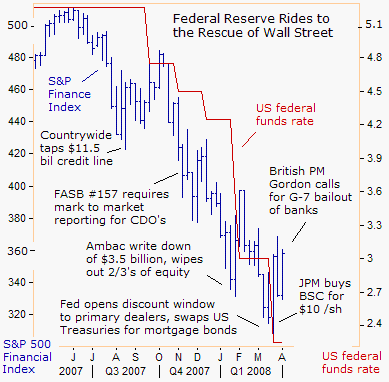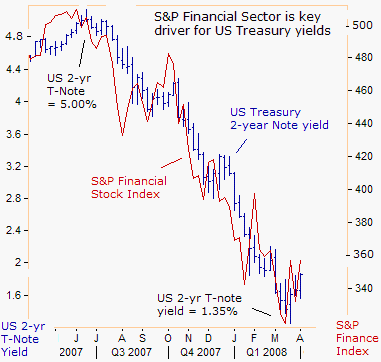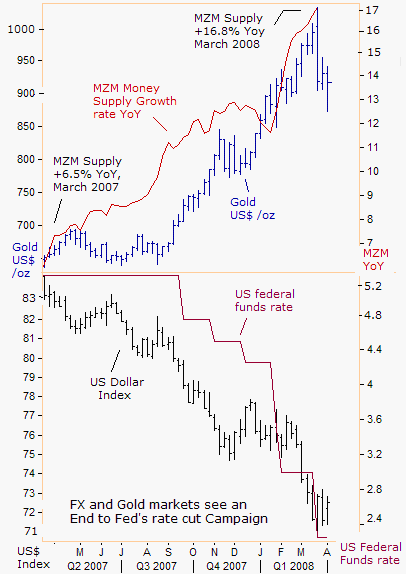|
|||
Tax Payer Bail-out Ideas Stabilize US dollar, Trip GoldGary Dorsch It was "April Fools" day, and Wall Street was busy spinning bad financial news into bouts of irrational exuberance. News of a $19 billion write-down of toxic sub-prime mortgage debt at Swiss bank UBS and a $4 billion hit at Deutsche Bank might have sparked a panic sell-off in global stock markets a few weeks ago. But on "April Fools" day, the Dow Jones Industrials soared 391-points, and the broader S&P 500 Index jumped 3.6%, posting its best 2nd-quarter start since 1938. Shares of UBS soared 18%, after the Swiss bank said it could plug the craters in its balance sheet with a $15 billion rights offering, led by a syndicate of JP Morgan, Morgan Stanley, BNP Paribas and Goldman Sachs. Shares of Lehman Bros jumped 22% after it raised $4 billion from the sale of convertible preferred shares, and squeezing bearish speculators in LEH puts in the process. Before the "April Fools" day festivities, the S&P 500 Index had posted five straight months of losses, and a 10% slide in the first quarter. In its infinite wisdom, the stock market has already discounted a recession, which probably arrived in the first quarter. Earnings for S&P 500 companies are expected -8.1% lower in Q1 from a year ago, down from rosy projections of +4.7% at the beginning of the quarter.  But the badly battered US financial sector soared 15% on "April Fools" day, after British PM Gordon Brown called on the Group of Seven central bankers, to stop worrying about "moral hazard" and start backing a joint plan to recapitalize global banks and buy-out the toxic sub-prime mortgages, to rescue the banking system. Of course, such a bailout initiative would be funded with taxpayer's money, with a small price of tougher regulation of the industry. "We have got to make these changes immediately," Brown said on April 1st. British PM Brown discussed
his solutions for the global banking crisis with US President
Bush at a NATO summit on April 3rd. "We were talking about
major issues that we can collectively do about the world economy,"
he told reporters. Brown is also talking with the leaders of
Germany, France, "about how we can make changes that we
need in the world economy, as quickly as possible." The earliest hint of a G-7 bailout plan was first proposed by Japan's financial services minister Yoshimi Watanabe on March 24th. "It is essential for the US to understand that given Japan's lesson, public fund injection into the financial sector is unavoidable. We could convey this lesson at the G-7 central bank meeting, and we are prepared to take coordinated action, to help resolve the issue," Watanabe said. Is speculation of a US government led bailout to rescue the banking industry a realistic proposition, or just a nasty "April Fools" joke? Washington might be left little choice but to lead a taxpayer bailout for banks choking on toxic sub-prime mortgages, because a rising tide of home foreclosures could crush the US economy without such a plan. There are hundreds of billions of dollars worth of home mortgages in arrears, in foreclosure or that homeowners have walked away from. US Treasury Secretary Henry Paulson now says he's flexible to new ideas of intervention. Free market capitalism is out of favor in Washington, and in its place, government intervention is the norm of the day. Voters are demanding immediate help, especially after the Fed-engineered bailout of Bear Stearns and its massive financial assistance to other Wall Street dealers. The Bear Stearns bailout has opened the doors for US politicians facing re-election to call for bailouts of distressed homeowners. There is a long history of
US government bailouts. In the late 1980's and early 1990's,
more than 1,000 savings and loan institutions failed, leading
to a federal bailout totaling roughly $125 billion. In 1975,
President Ford provided a struggling New York City with a $7
billion loan package. President Clinton came to Mexico's aid
in 1995 after a sharp devaluation of the peso, with $50 billion
of loans. Just how costly a US government bailout to purchase existing sub-prime mortgage loans is anyone's guess, but it's probably much cheaper than the cost of the FDIC paying off depositors of failed banks. It would certainly be much less than the $845 billion that Congress has already appropriated for military operations, reconstruction, embassy costs, and US bases and foreign aid programs in Iraq and Afghanistan.  A massive US government bailout would add hundreds of billions to the outstanding supply of US Treasuries, but greatly relieve the stress in the banking system. It could unleash a rapid unwinding of "safe haven" positions in US 2-year T-notes, and lift US interest rates sharply higher. It could also trigger a reversal of the Fed's rate cuts since September and a tighter US money policy in the second half of 2008. With the yield on the US Treasury's 2-year note jumping to 1.95% this week, from a record low of 1.35% two weeks ago, it's already narrowed the scope of a Fed rate cut in April to a quarter-point. In testimony on Capitol Hill on April 3rd, Fed chief Ben Bernanke said, "The effects of monetary of policy are felt over a period of time and we expect to see positive effects of these policies going forward." Until then, Fed policy might stay on hold at 2% because, "there's a chance in the first half there might be a slight contraction," Bernanke said.  Expectations that the Fed's rate cutting campaign is nearing an end, has stabilized the US dollar, with the greenback's strongest gains seen against the Japanese yen, which offers negative rates of interest after adjusting for inflation, and the British pound, in anticipation of gradual rate cuts by the Bank of England. The Bank of Canada is expected to match any residual Fed rate cut in this cycle. The Gold market was rattled after its historic rally fizzled out above the psychological $1,000 /oz level, and surprising moves by the Federal Reserve to drain some excess cash out of the US banking system, after the rescue of Bear Stearns. But Mr Bernanke and his radical band of inflationists at the Fed, have expanded the MZM money supply by 16.8% from a year ago, which could ignite hyper-inflation in the US economy, once the monetary stimulus in the pipeline starts to take effect. To read the rest of this article, please click on the link below: http://www.sirchartsalot.com/article.php?id=81 Gary Dorsch |
